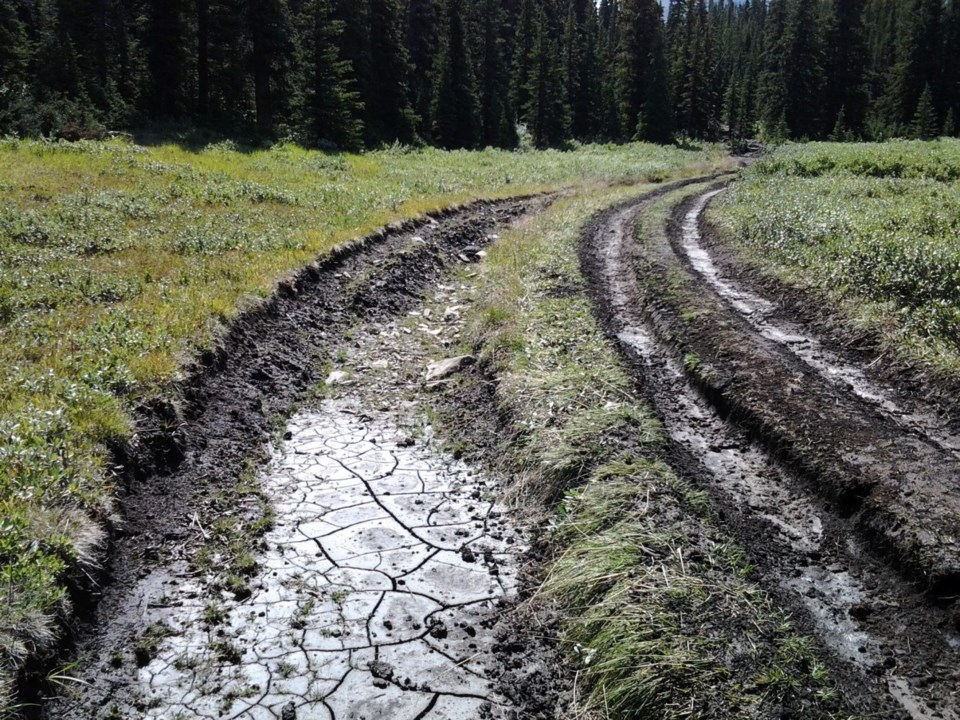Scott Hayes | [email protected]
Local Journalism Initiative Reporter
The report has just come in and it contains damaging findings.
The Alberta Wilderness Association (AWA) conducted an extensive 15-year research and monitoring project of off-highway vehicle (OHV) use in the Bighorn Backcountry. Recently released, the reveals severe damage to the trails and the surrounding landscape as a direct result of OHV use.
"Fifteen years is a pretty significant amount of time to look for trail damage,” said Devon Earl, AWA conservation specialist.
“We were able to show severe and increasing damage to trails over that time in the form of erosion and trail widening and the creation of secondary trails and rutting and things like that."
The Bighorn Backcountry is a large and important wilderness area located within both the Rocky Mountains and the Foothills in a gap between Banff and Jasper National Parks.
AWA staff and volunteers focused this report on the Hummingbird Area Trail Network, a network of eight trails located within the Prime Protection Zone identified in the province's (AENR 1984). These were originally meant for equestrian use.
This is where the largest OHV trail system was established under the Bighorn Backcountry Access Management Plan (AMP) in 2002. Doing so contravened the intentions of the Eastern Slopes Policy, which explicitly states that motorized recreation was incompatible with the area.
Every time that there was an incident of trail damage, the AWA took a photo and marked the location, and actually measured the depth of the erosion and the width of the trail.
Off-highway vehicle use in the Bighorn Backcountry reduces water quality in the headwaters of the North Saskatchewan River, which affects human drinking water in Edmonton and farther down the river and across the Prairies.
OHVs also damage soil and vegetation and also destroy fish habitat, according to Earl.
"In a lot of cases, you could tell that there were tire marks, and things like that," she said, noting that horse tracks were also observed and noted in the report. "Off-highway vehicles are definitely the most high-impact activity that takes place out there."
Some of the key findings of the report show that trail damage has increased significantly, with 344 observations of trail damage (including rutting, widening, erosion, braiding and secondary trails) recorded in the focus area between 2012 and 2017. That is a 247 per cent increase from the reporting between 2003 to 2008.
The AWA also documented 46 instances of an OHV trail crossing a stream or other water body throughout the trail network in 2017 alone.
"The particular topography, soil types and plant communities found in the Bighorn are unable to support intensive motorized recreation," the report reads.
"The extreme trail erosion observed throughout the monitoring period, particularly after high rainfall events and ad hoc reconstruction, confirmed that motorized recreation is incompatible with protection of the pristine wilderness values of the Bighorn Backcountry."
When the AMP came into effect in 2002, the AWA decided that tracking trail damage was an important activity to help protect the important ecological area. The area should be protected, Earl said.
While OHVs have been permitted on designated trails since that year, the AWA has also tracked evidence of illegal use on undesignated trails and even on trails that were closed at the time due to flooding or for seasonal restrictions as a tool to help mitigate further trail damage. When trails are wet is the time when they are most susceptible to damage.
"The AWA has been advocating for its protection. It was also promised by the Government of Alberta for protection, I think, in 1986, but that just never went through," Earl said.
"Ideally, we would have liked to see this area protected, but at least if we can't have a protected area there, we'd at least like to see that off-highway vehicles are only allowed in areas where it's sustainable so that we can protect the integrity of the area as best we can."
She noted that Albertans consistently rank healthy environment and ecosystems as the number one priority for land-use planning.
The AWA urges the Government of Alberta to restrict motorized access in the Prime Protection Zone of the Bighorn Backcountry to trails that can support it, and to increase enforcement of rules governing OHV use. These steps are necessary to prevent further and possibly irreversible damage to this important wilderness area.
The 51���� requested a response from the Alberta Off-Highway Vehicle Association, one of the two groups (the other being the Alberta Snowmobile Association) that the province has designated as trail managers. No response was received by press time.
Minister of Forestry and Parks Todd Loewen was unavailable for an interview. The ministry provided a prepared statement, which began by citing the to managing the Bighorn Backcountry. It also cited its commitment to protecting the area while continuing to offer outdoor recreation opportunities.
There has been substantial increase in visitation in recent years, which has put pressure on the landscape, it stated.
"The Ministry of Forestry and Parks is managing this increase in visitation in a sustainable and safe manner by focusing on public education and investing in trails and projects in the area. The area is proactively patrolled by conservation officers who educate and enforce the regulations to keep the area safe."
The ministry added that conservation officers have the authority to implement closures in response to environmental or safety concerns.
Albertans can report public safety incidents, illegal activity and enforcement concerns (including improper use of off-highway vehicles and illegal trails) by calling 310-LAND (5263).
"Alberta’s public lands showcase the diversity and beauty of the province, and it is important to ensure the public has reasonable access to these areas,” the ministry’s statement read.
“Revenue from the Public Lands Camping Pass has been invested to maintain infrastructure and camping areas, improve education, support conservation, monitor and enforce rules, promote public safety and provide services, including waste management."




